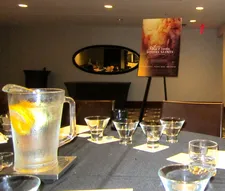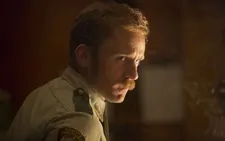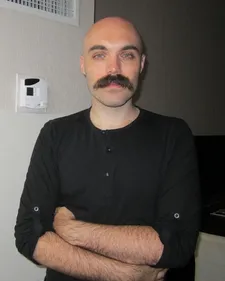 |
| Rooney Mara and Casey Affleck as Ruth and Bob in David Lowery's Ain't Them Bodies Saints. Director David Lowery: 'I wanted the characters to really feel as if they could have been alive at any time.' |
Anne-Katrin Titze: I was struck by the timelessness of your film. It works like a palimpsest. At times Rooney Mara's character Ruth Guthrie seems like a pioneer woman, then a character living during the Great Depression, then the 1970s. Are these time layers something you were balancing?
David Lowery: Absolutely. I love that you used the word palimpsest. I love the idea of being able to see the lineage of what something used to be in years past and that you can never quite erase. You never have a full tabula rasa. What I wanted to do with the movie was have it be almost free of immediate context. I didn't want it to feel bound to one time period. As soon as we did that, it would be limiting the story. I wanted the characters to really feel as if they could have been alive at any time. Like you said, Rooney could have been a pioneer woman or during the Great Depression. She could have been a flower child. They are archetypes so they kind of function across time.
By setting the movie in an aimless, timeless context, it actually made it more immediate. If they turned on the TV and there was a report on the Vietnam War or if they walked past a movie theatre and there was Star Wars, or some other movie from the 70s, you would have immediately contextualised the film and it would have felt like a movie that was about that time period. It's about something that happened in the past. By not isolating it in any specific moment it gave the story a currency that I felt is valuable.
Ain't Them Bodies Saints is a film of precise gestures and American memories, made up and yearned for, written to last on wind and sunshine.
 |
| The scene at the W Hotel, Union Square, in New York Photo: Anne-Katrin Titze |
DL: That's exactly what I wanted to do. As a fan of film and story-telling in general, I always gravitate towards things that have an emotional immediacy. Plot mechanics are good and logic is good and I respond to that as well. But I'm much more interested in just having an immediate emotional experience.
AKT: What are some of the movies where you felt that?
DL: That's a great question. You know, whenever someone asks me anything about movies I always blank out on what they are. One of my favorite filmmakers is Claire Denis. I think Beau Travail (1999) is a tremendous example of a movie where you don't really know what's going on. The Intruder (2004) is another one of hers.
Pretty much all of her movies. These two especially are so free of context. They have a very specific context and there is a logic to them but you are thrown into the movie and forced to deal with things on an emotional level. When I first saw Beau Travail that was a movie that completely changed my idea of what cinema could do. Much in the same way that Virginia Woolf did with literature. I love the idea of just experiencing these moments and having these images. I don't quite know what's going on within them but they mean so much to me in the moment and they have such tremendous weight and so much impact. You are having an emotional narrative experience. You have story-telling logic there that is secondary to the emotional experience.
AKT: You bring up Virginia Woolf. Any particular scene or a specific novel that could illustrate that point? Claire Denis and Virginia Woolf are unexpected references in the context of Ain't them Bodies Saints.
DL: You know in To The Lighthouse, when they make that big jump forward in time?
AKT: Yes, in chapter two.
DL: Yeah. That's something that amazed me. You are making that great leap and yet it feels like you're not skipping a beat. It flowed so thoroughly. It's easy to cite [Woolf's] Mrs Dalloway, that's the first one I read. To realise that you are plunging so deeply into a single moment. You're taken aback, accepting a moment with language and using the flow of language and the rhythm to communicate an emotion. And then in To The Lighthouse when she makes that formal jump forward that you don't expect, it sort of does the opposite of what Mrs Dalloway did and creates this gulf between two events.
AKT: It's hard to believe for me that you bring up To the Lighthouse. Yesterday, less that 24 hours ago, I interviewed David Siegel and Scott McGehee, the directors of What Maisie Knew, and I brought up To The Lighthouse to them in the context of childhood promises. David Siegel even took out his notebook to jot the title down to read it. Tell me about your characters' names. Bob Muldoon (Affleck) and Patrick Wheeler (Foster) fit really well, you couldn't switch the character's names.
 |
| Ben Foster as Patrick in Ain't Them Bodies Saints. David Lowery: 'I gave him my middle name because I felt very close to that character.' |
AKT: The title of your film has the same qualities that I described earlier. My mind doesn't understand what the title means at all, yet emotionally I agree with the question it implies. Of course they are saints!
DL: That's great. People ask me and I break it down - here's kind of what the title means, but I'd rather not. The audience, they are buying a ticket for a movie that's called Ain't Them Bodies Saints. In a way, the title is preparing you for the movie you are about to see. It doesn't matter that the title never comes up in the movie. It's not a plot related title, it's about creating a feeling. That title is a first step in creating a tone in which the rest of the movie is going to function.
AKT: I love the image chosen for the US poster. Rooney Mara wears the faded floral shift dress with the plaid shirt tied around her waist. The masculine, the feminine and the timelessness all knotted together. Tell me about the costume choices.
 |
| David Lowery: 'I always gravitate towards things that have an emotional immediacy.' Photo: Anne-Katrin Titze |
She said 'if you want me to wear it, I'll wear it but I really feel that Ruth would wear older things, things that are more feminine.' She went to the wardrobe truck and came out wearing that dress with the flannel shirt tied around her waist. And I said, 'Okay, you were right. This is who Ruth is'. She saw the opportunity to really define the character for herself and it was completely the right choice. The flannel shirt was important because later on she wanted something to remind her of Bob. Having the dress and having her boyfriend's shirt tied around her waist gave her that sense of him being there all the time.
AKT: It is also hugging the baby.
DL: Exactly. I love that Virginia Woolf came up twice in 24 hours!
In David Lowery's scrupulous and unperturbed Ain't Them Bodies Saints, prairie fantasies and outlaw escapes surge into the great American love story.
The film opens in the US on August 16 and in the UK on September 6.





















